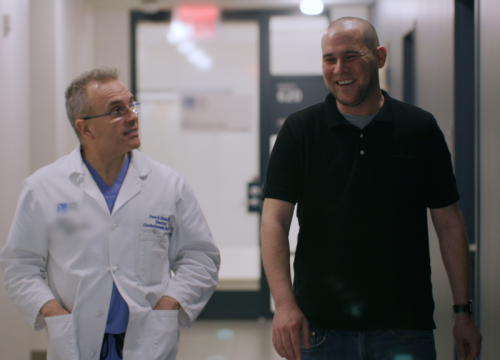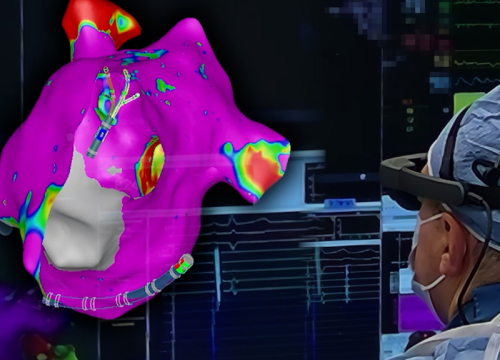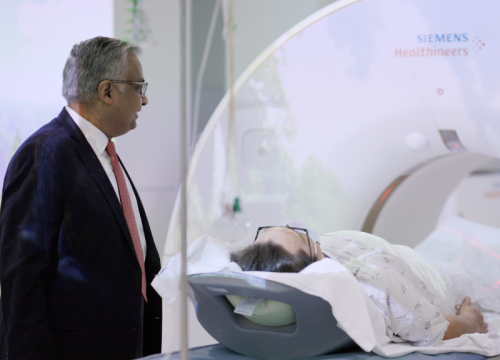Radiation therapy (also referred to as radiotherapy or X-ray therapy) is a cancer treatment used to destroy and/or shrink cancer.
Radiation therapy can be used:
- Alone to destroy tumors
- In combination with chemotherapy or other drugs to treat cancer
- Before surgery to shrink a tumor enough so it can be removed
- After surgery as adjuvant treatment (treatment used in addition to the primary treatment) to prevent a recurrence
- As palliative therapy to relieve symptoms caused by the cancer
Types of Radiation Therapy
The type of radiation therapy you receive will depend on a variety of factors, including the type of cancer, the size, location and stage of your tumor. There are two main types of radiation therapy, external beam and internal radiation.
External Beam Radiation at Valley
With external beam radiation, the source of the radiation or X-rays is outside of your body. External beam radiation is most commonly delivered by a linear accelerator.
Valley is the first hospital in the area to offer next-generation technology — ExacTrac Dynamic by Brainlab — that improves the accuracy of external beam radiation therapy.
This new technology allows us to incorporate additional views from both outside (surface guided radiation therapy, or SGRT) and inside (image-guided radiation therapy, or IGRT) your body. To do this, we use high-resolution surface and thermal imaging and X-ray imaging before and during treatment delivery. These additional views more precisely account for your body’s normal movements (such as during breathing) so we do not overtreat normal tissue.
We offer the following types of external beam radiation therapy at Valley-Mount Sinai Comprehensive Cancer Care:
Stereotactic Radiosurgery
Valley offers the Gamma Knife Icon for stereotactic radiosurgery. Stereotactic radiosurgery is a non-surgical radiation treatment that delivers a high dose of concentrated, targeted radiation (X-rays) to the brain. For more information, visit our Gamma Knife Center.
Cancers treated: Brain tumors, metastatic brain tumors, benign diseases (Trigeminal Neuralgia, Acoustic Neuromas, Arterior-venous malformations (AVM), Meningiomas and others).
Stereotactic Body Radiotherapy (SBRT)
Valley offers the TrueBeam linear accelerator-based SBRT. Stereotactic body radiotherapy is a targeted, non-surgical radiation treatment for tumors in the body. Visit stereotactic radiosurgery for more information about SBRT’s uses at Valley.
Our radiation oncologists also use a “Think Five” protocol to treat prostate cancer. This approach delivers a full course of treatment in only 5 radiation sessions, rather than the standard course of up to 45 sessions.
Cancers treated: Lung cancer, prostate cancer, brain cancer, metastatic cancers, liver cancer, kidney cancer, spinal cancer, pancreatic cancer
Internal Radiation at Valley
With internal radiation therapy, the radiation (X-ray) source is placed inside your body. We offer the following types of internal radiation:
HDR Brachytherapy
At Valley, we offer high-dose rate brachytherapy, or HDR brachytherapy. This type of brachytherapy uses a high-dose rate afterloader to temporarily deliver high doses of radiation to small, clearly defined sites. Because of the strength and control of the high-dose rate source (the afterloader device), patients only need a few outpatient treatments.
Cancers treated: Skin cancer, gynecologic cancers (uterine, cervical and vaginal cancers)
Radiation Therapy Treatment at Valley
CT simulation, 4D treatment planning, and high-resolution internal and external imaging during treatment are the standard at Valley-Mount Sinai Comprehensive Cancer Care to plan each individual patient’s radiation therapy regimen:
CT simulation
- CT simulation is the process for identifying the location, size and shape of your tumor.
- At Valley, all our CT scanners are calibrated and monitored to ensure optimal scan data with minimal exposure to the patient. That means patients receive as little radiation as possible.
Treatment planning
- Your CT scan data is combined with surface and thermal imaging using 300,000 points of reference — 10 times more than most systems — to plan radiation treatments. Our system creates a 4D “virtual patient” from these scans by creating a 3-dimensional map and then taking into account any involuntary motion such as breathing.
- Our radiation oncologists can see all of the tissue, bone and air cavities that fall in the path of the radiation beam; they then analyze them to determine how much radiation will be delivered to each area and create a custom plan to treat the intended area while minimizing exposure to healthy surrounding normal tissues.
High-resolution internal and external views during treatment
- We merge these planning scans with real-time scans, so we view your anatomy in 4D from both internal and external views during treatment while accounting for involuntary motion.
- Our new Brainlab technology gives us the ability to see and account for the normal movements of your body more precisely. This helps us to target the tumor within millimeters with the appropriate maximum dose and deliver minimal radiation to normal structures.
Specialized techniques
- Deep inspiration breath hold (DIBH): minimizes radiation exposure to the heart in breast cancer in the left breast; patients take a deep breath and hold it during radiation. The treatment machine is programmed to sense if the patient is holding their breath and will only deliver radiation during the breath hold. If the patient starts to breathe again the machine will automatically shut off and resume where it left off during the next breath hold.
- Prone breast radiation: for women with larger breasts, the patient lies on her stomach during breast cancer radiation to minimize exposure to the heart and lungs and reduce skin reaction.
- Fiducial/SpaceOAR: a gel-like material that temporarily moves the rectal wall away from the prostate during radiation therapy to minimize treatment side effects.
- Gated treatments: For cancers or targets that are moving because of a patient’s normal respirations, the treatment machine can be programmed to sense when the target is in the appropriate position and only deliver radiation at that time. When the target moves out of range, the machine will shut off until it comes back into range and then resume treatment delivery.
Why Choose Valley for Radiation Therapy?
- Innovative expertise: Valley’s radiation oncology program has a long track record of incorporating the latest technologies — like Gamma Knife radiosurgery, brachytherapy for prostate cancer, and now ExacTrac Dynamic.
- Accredited radiation care: Valley’s radiation oncology program is accredited through the American College of Radiology (ACR) and the American Society for Radiation Oncology's (ASTRO) Accreditation Program for Excellence (APEx®). This means that our program meets the highest national standards for delivering radiation safely.
- Focus on patient safety: Our goal with each radiation treatment is to safely deliver the dose required to treat your cancer with the minimum amount of radiation delivered to normal tissues. That’s why we use techniques like deep-inspiration breath hold, surface guided radiation therapy (SGRT) and image-guided radiation therapy (IGRT), and why we invest in the most advanced technologies like Gamma Knife, ExacTrac Dynamic by Brainlab and use 4D simulation planning.
















